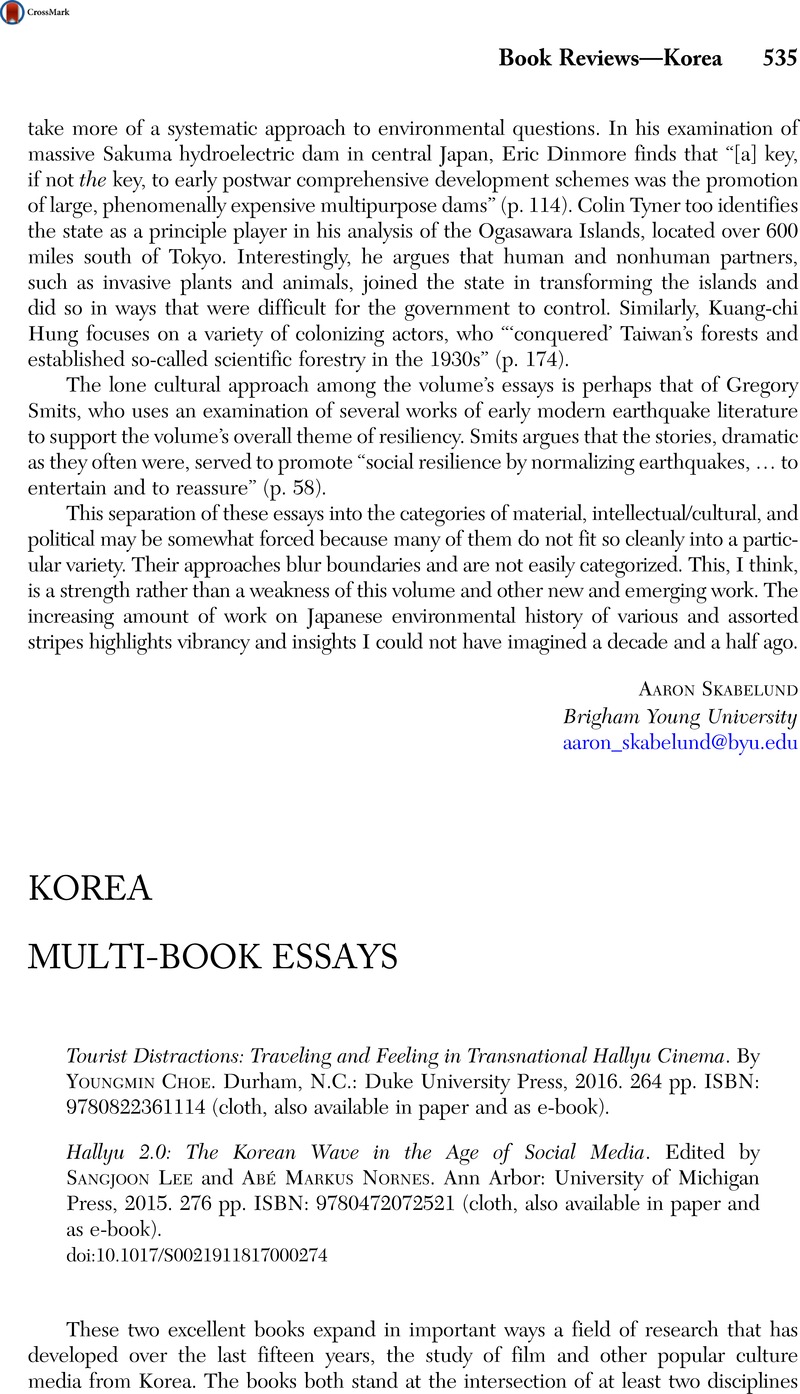No CrossRef data available.
Article contents
Tourist Distractions: Traveling and Feeling in Transnational Hallyu Cinema. By Youngmin Choe . Durham, N.C.: Duke University Press, 2016. 264 pp. ISBN: 9780822361114 (cloth, also available in paper and as e-book). - Hallyu 2.0: The Korean Wave in the Age of Social Media. Edited by Sangjoon Lee and Abé Markus Nornes . Ann Arbor: University of Michigan Press, 2015. 276 pp. ISBN: 9780472072521 (cloth, also available in paper and as e-book).
Published online by Cambridge University Press: 04 May 2017
Abstract

- Type
- Book Reviews—Korea
- Information
- Copyright
- Copyright © The Association for Asian Studies, Inc. 2017
References
1 Some important works from this trajectory are: Lee, Hyangjin, Contemporary Korean Cinema: Identity, Culture and Politics (Manchester: Manchester University Press, 2001)Google Scholar; Kim, Kyung Hyun, The Remasculinization of Korean Cinema (Durham, N.C.: Duke University Press, 2004)CrossRefGoogle Scholar; Shin, Chi-Yun and Stringer, Julian, eds., New Korean Cinema (Edinburgh: Edinburgh University Press, 2005)Google Scholar; McHugh, Kathleen and Abelmann, Nancy, eds., South Korean Golden Age Melodrama: Gender, Genre, and National Cinema (Detroit, Mich.: Wayne State University Press, 2005)Google Scholar; Leong, Anthony, Korean Cinema: The New Hong Kong, A Guidebook for the Latest Korean New Wave (Victoria, B.C.: Trafford Press, 2002)Google Scholar; Gateward, Frances, ed., Seoul Searching: Culture and Identity in Contemporary Korean Cinema (Albany: State University of New York Press, 2007)Google Scholar; Huat, Chua Beng and Iwabuchi, Kōichi, eds., East Asian Pop Culture: Analysing the Korean Wave (Hong Kong: Hong Kong University Press, 2008)Google Scholar; Kim, Do Kyun and Kim, Min-Sun, eds., Hallyu: Influence of Korean Popular Culture in Asia and Beyond (Seoul: Seoul National University Press, 2011)CrossRefGoogle Scholar; Kim, Kyung Hyun, Virtual Hallyu: Korean Cinema of the Global Era (Durham, N.C.: Duke University Press, 2011)CrossRefGoogle Scholar; Kim, Youna, ed., The Korean Wave: Korean Media Go Global (London: Routledge, 2013)Google Scholar; Kim, Kyung Hyun and Choe, Youngmin, eds., The Korean Popular Culture Reader (Durham, N.C.: Duke University Press, 2014)CrossRefGoogle Scholar; Marinescu, Valentina, ed., The Global Impact of South Korean Popular Culture: Hallyu Unbound (Lanham, Md.: Lexington Books, 2014)Google Scholar; Choi, JungBong and Maliangkay, Roald, eds., K-pop: The International Rise of the Korean Music Industry (London: Routledge, 2014)Google Scholar; Lie, John, K-Pop: Popular Music, Cultural Amnesia, and Economic Innovation in South Korea (Berkeley: University of California Press, 2014)CrossRefGoogle Scholar; Jackson, Andrew David and Balmain, Colette, eds., Korean Screen Cultures: Interrogating Cinema, TV, Music and Online Games (Oxford: Peter Lang, 2015)CrossRefGoogle Scholar; Fuhr, Michael, ed., Globalization and Popular Music in South Korea: Sounding Out K-Pop (London: Routledge, 2015)Google Scholar; Chung, Hye Seung and Diffrient, David Scott, Movie Migrations: Transnational Genre Flows and South Korean Cinema (New Brunswick, N.J.: Rutgers University Press, 2016)Google Scholar.


